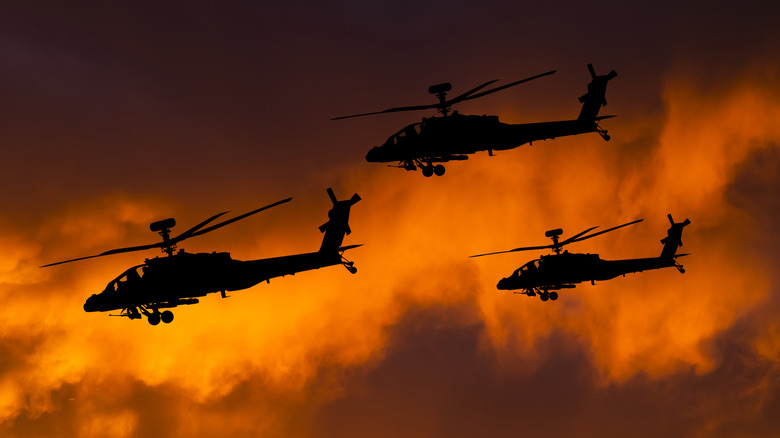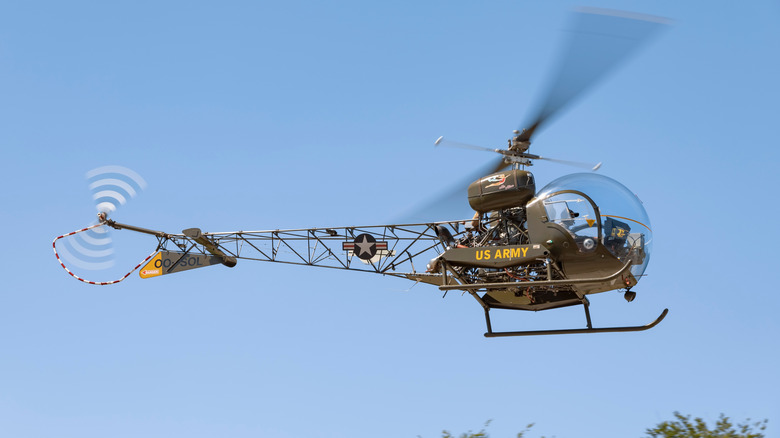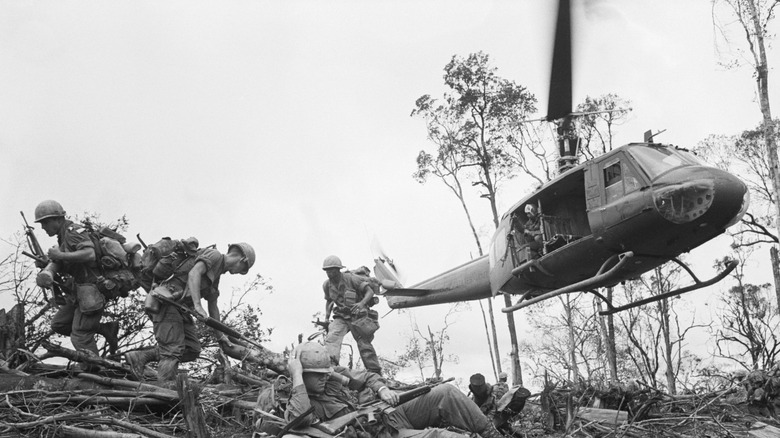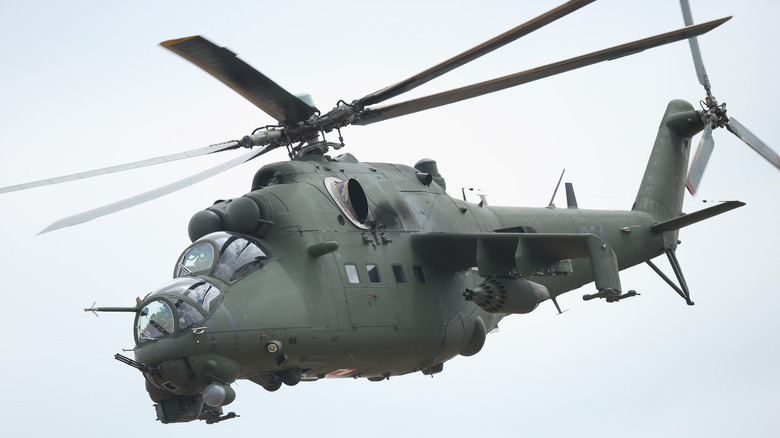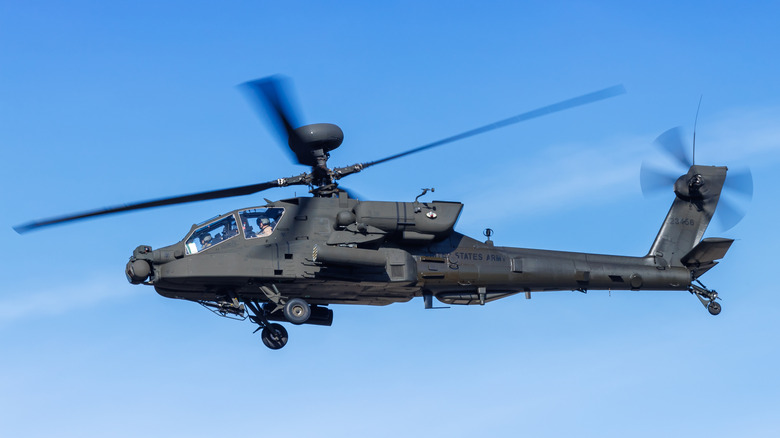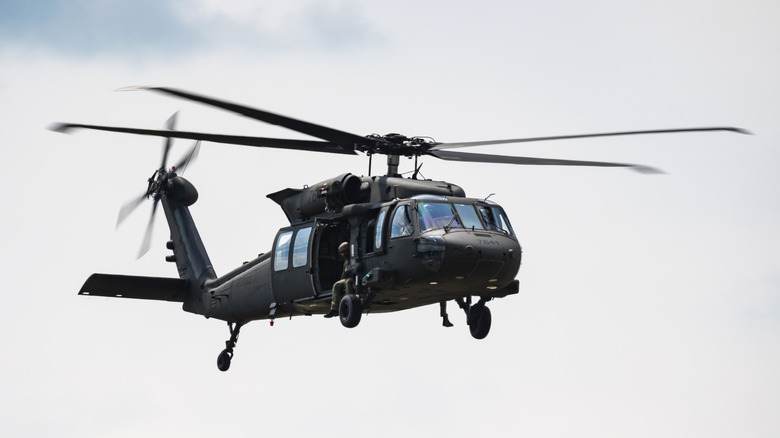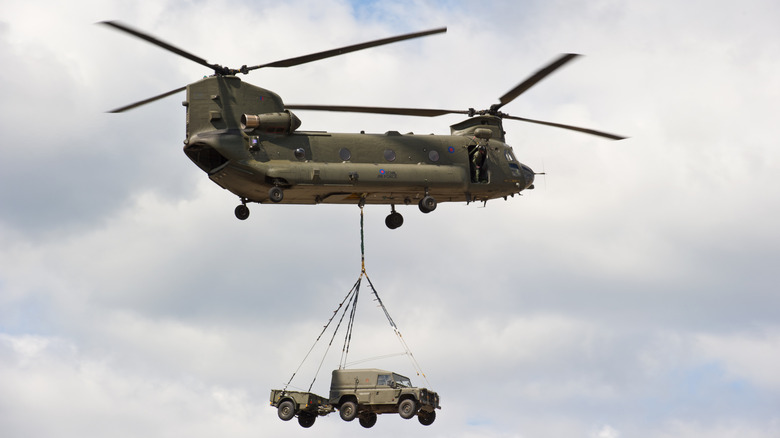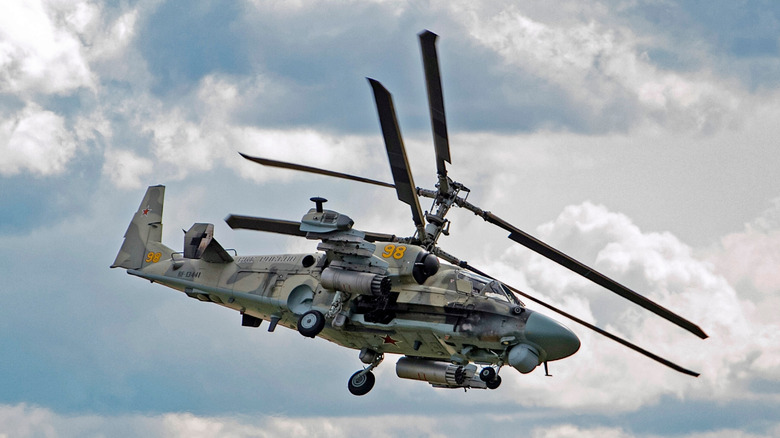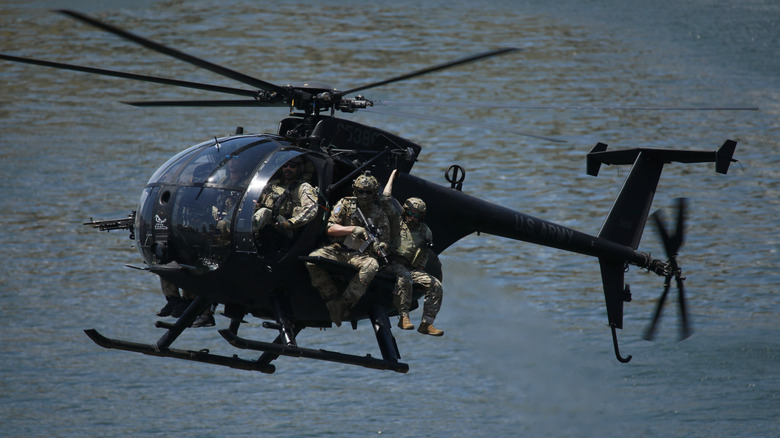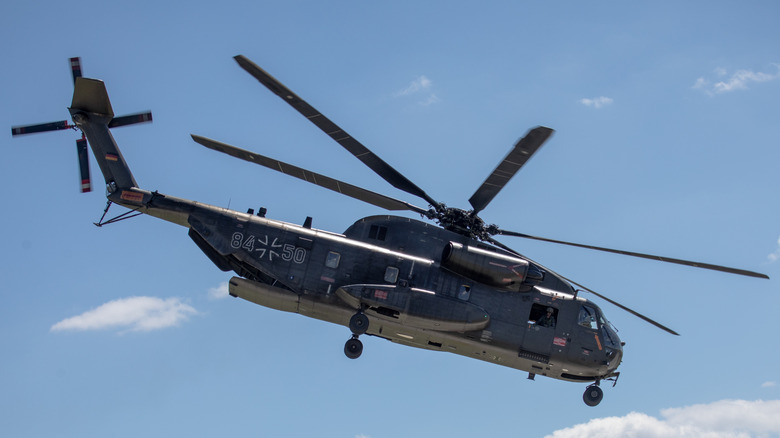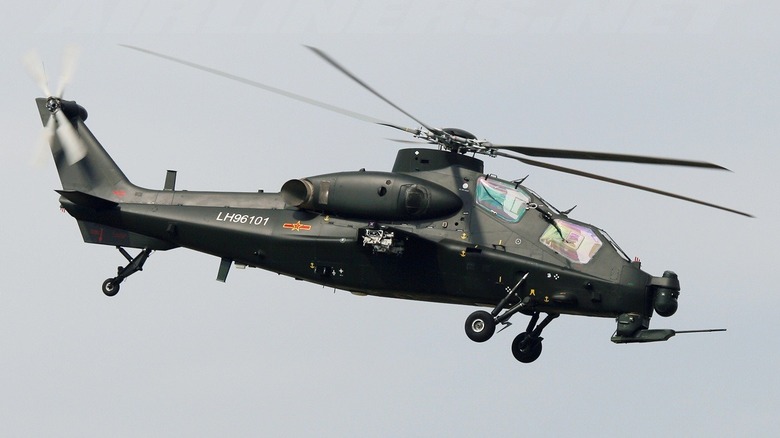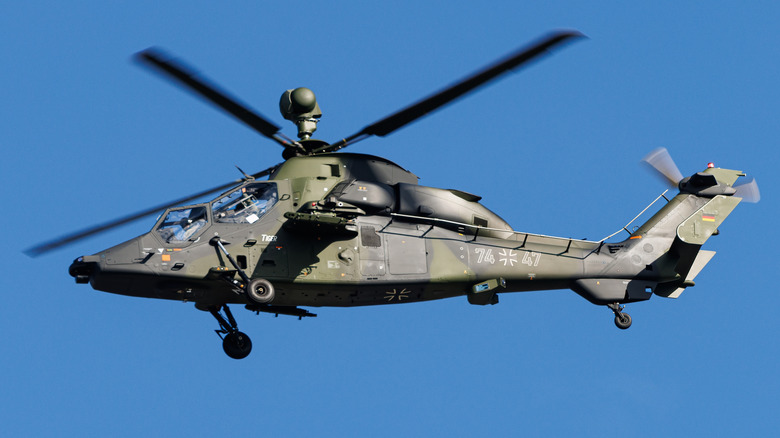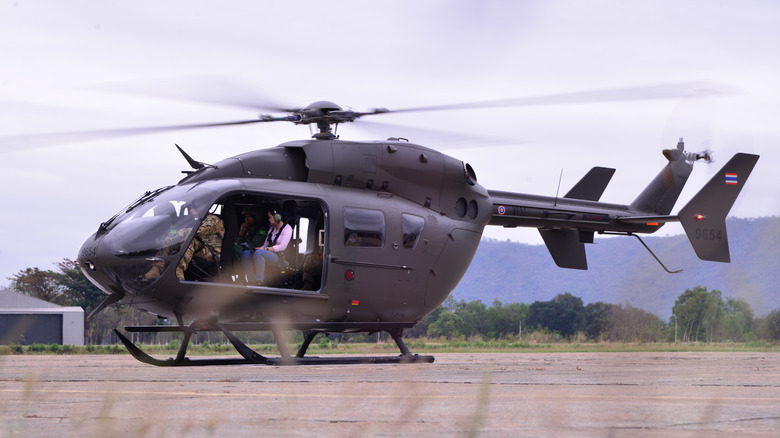12 Of The Most Iconic Military Helicopters In History
Helicopters have their roots in the pre-World War II era. Renaissance genius Leonardo Da Vinci famously conceptualized his aerial screw as far back as the 15th century, though the inventor never built the design. Like many of Da Vinci's unsung inventions, engineering had to catch up with his thinking. It would not be until the early 20th century that it finally happened.
On Sept. 29, 1907, French brothers and engineers Louis and Jacque Breguet accomplished a brief tethered flight in Gyroplane No 1., a 45-hp contraption that achieved an altitude of about a foot. Around the same time, the father of the helicopter, Igor Sikorsky, experimented unsuccessfully with his own designs. After decades of labor, Sikorsky's dream finally took flight on Sept. 14, 1939, when the world's first true helicopter, the VS-300, rose into the air outside of Stratford, Connecticut.
While the new technology arrived too late to participate in the second World War, it has left an indelible mark on every significant conflict since. Helicopters have revolutionized air power, prompting militaries to develop entire strategies around them. Their capabilities made them indispensable to any comprehensive battle plan. Every professional military force utilizes helicopters to save or take lives, transport materiel or move people in battle. In honor of helicopters' enormous impact, we explore 12 of the most iconic military helicopters in history.
Bell 47
The Bell 47 helicopter is the first to see widespread use in the U.S. military. Lawrence Dale Bell founded the Bell Aircraft Corporation in Buffalo, New York, in 1935. Though the company initially focused on fixed-wing aircraft like the Bell P-39 Airacobra, it soon turned to helicopters, renaming itself the Bell Helicopter.
The Bell 47 prototype took its first flight on Dec. 8, 1945. It soon set about becoming the first helicopter certified by the Civil Aeronautics Authority (CAA) and breaking altitude and speed records by achieving up to 18,500 feet and nearly 154 mph. Bell continued to develop its model; the Bell 47D achieved certification in February 1948, after which the military took notice.
The U.S. Army ordered 65 of the 47Ds, which it dubbed the H-13 Sioux, while the Navy ordered 12, which it designated HTL-2. The distinctive bubble canopy gave pilots serious visibility. A 200 hp Franklin engine provided a cruising speed of 85 mph and the craft packed enough oomph to transport wounded soldiers from the battlefield in record time.
The Bell 47 also got plenty of screen time in the television show M.A.S.H., which portrayed a hospital unit in the Korean War for 11 seasons. Its sterling service and a cross into pop culture make the bug-like Bell 47 one of the most iconic helicopters in military history.
Bell UH-1
Though the Bell 47 proved itself in battle, technology soon outpaced the rudimentary chopper. When America again went to war, its successor would become one of the most famous helicopters in the world.
The Army wanted a replacement for the 47D, and the Bell Corporation was happy to oblige. The Bell UH-1, known colloquially as the Huey, first flew in 1956. A generational revolution, the new helicopter became closely associated with America's war in Vietnam. The Huey entered operations as a medevac in 1962. It would become synonymous with the Vietnam War, not to mention Creedence Clearwater Revival's "Fortunate Son."
The Huey proved multidimensional. Its 1,400 hp turboshaft engine provided a range of 318 miles, a maximum altitude of 12,600 feet, and a cruising speed of 127 mph. It could carry up to 12 troops (or three to six wounded men). The United States formed its entire Vietnam War strategy around it. Army aviation units flying the Huey inserted infantry deep into enemy territory, a critical ability given Vietnam's amorphous front lines. Hueys went on to do everything from resupplying troops to performing as gunships to bringing the wounded and dead back to base.
The Huey transcended mere military hardware to become a symbol of a tumultuous era of American history. So effective were the Huey helicopters that by the end of the 20th century, Bell had built more than any other American military aircraft besides the Consolidated B-24 Liberator bomber.
Mi-24
The U.S. wasn't the only nation in the helicopter game. The exigencies of the Cold War meant the Soviet Union competed fiercely to provide a near-peer or superior rotor aircraft.
One of its prominent gunships, the MIL Mi-24, known by the NATO codename "Hind," began development in the mid-to-late 1960s. Unlike the do-everything Huey, the Hind's primary function was to supply close air support against armored targets.The Hind first hit the Soviet armed forces in 1972, evolving throughout the decade until its most famous variation, the Hind D, emerged as one of the premier attack helicopters of the age.
It featured a distinctive double-bubble cockpit, placing the pilot/gunner in front of and below the pilot/commander. Its tank-killing machine called for a 12.7 mm rotating machine gun turret mounted beneath the nose. Additionally, the Hind features hard points for mounting bombs, 122 mm rockets, and guided anti-tank missiles. It could also ferry infantry into battle. Up to eight troops or 14 stretchers fit into its rear compartment. Part of what made the Hind capable of carrying so much was its use of a pair of Klimov turboshaft engines, each making nearly 2,200 hp, driving a five-blade main rotor and three-blade tail rotor. The Hind became an icon of the Cold War era.
AH-64 Apache
The United States had its answer for the dedicated gunship helicopter. In 1967, Bell converted the multifaceted UH-1 Huey into the AH-1 Cobra attack helicopter. The Cobra is one of the oldest military helicopters still in service today, but its spiritual successor, the AH-64 Apache, took the concept to the next level.
The AH-64A debuted in 1974 and progressed through the years into the current sixth-generation AH-64E. Compared to the Mi-24, the Apache is similar in its mission to inflict heavy damage on ground targets. The latest and greatest version uses two General Electric engines, each good for 1,700 hp.
For armament, it uses a quartet of firing rails to mount up to 16 missiles. The gunner directs the missiles by aiming a laser beam at the target. The Apache also hosts detachable pods holding up to 19 unguided 2.75-inch aerial rockets, which can hold warheads containing everything from smoke to cluster munitions.
The Apache's most iconic weapon is its underslung-nose mounted 30 mm chain gun. Either pilot can slave the weapon to his helmet, allowing him to aim by simply looking at the target. A slew of sophisticated avionics and targeting systems aid the rear-seat pilot and forward-seat gunner/co-pilot in tracking and engaging multiple targets.
It first saw combat duty in Panama in December 1989. Since then, the United States and its allies have deployed the Apache to multiple battle zones, and it remains a central component of the U.S. Army's aviation power.
Sikorsky UH-60 Black Hawk
If the Apache is the spiritual successor to the Huey-based Cobra, then the Black Hawk takes up the do-it-all role of the Huey itself. It is perhaps most famous for the October 1993 Black Hawk Down incident in Mogadishu, Somalia, but that is just one chapter in a long story of service for the UH-60 Blackhawk.
The Black Hawk is a product of the Sikorsky company, founded by helicopter pioneer Igor Sikorsky in 1923. As the conflict in Vietnam was winding down, the Army looked to an updated replacement for the venerable Huey. Four prototypes entered the competition. With armor superior to that of the Huey, upgraded engines, and a maximum load capacity of 22.000 pounds, the Black Hawk won the contract, first entering service in 1979.
In the 40 years since the Black Hawk debut, it has received several upgrades. The latest is the UH-60M variant, with a pair of engines boasting up to 9,000 pounds of carrying capacity. It is capable of operating as a gunship, delivering troops, engaging in combat missions, and even in firefighting roles.
There are likely variants the public doesn't even know about. The 2011 raid on Osama Bin Laden revealed a previously unknown stealth variant when troops were forced to partially destroy a crashed Blackhawk, leaving behind the specially equipped tail rotor.
Lockheed Martin has built more than 5,000 of these helicopters for more than 36 nations, and the airframe retains a starring role in the world of rotorcraft.
CH-47 Chinook
Perhaps no military helicopter has a more iconic silhouette than the twin-engined, tandem-rotor CH-47 Chinook. Unlike the Apache, Blackhawk, or Hind, the Chinook is primarily used as a heavy-lift transport chopper. The CH in its name stands for "Cargo Helicopter." Alongside the Huey, the Chinook was one of the earliest helicopters to employ turbine engines.
The CH-47A entered Army service in 1962. Like the Black Hawk, the Chinook has received numerous upgrades, resulting in a modern iteration sporting two Honeywell engines, each generating nearly 5,000 hp. It can achieve a maximum speed of almost 200 mph and a cruise speed of 180 mph, qualifying it as one of the fastest military helicopters ranked by top speed.
As impressive as its speed is, the actual headline of the Chinook is its carrying capacity. It can lift nearly 48,000 pounds, meaning that it can carry cargo that won't even fit in its cargo bay, resulting in instances of everything from humanitarian pallets to Humvees slung beneath it on special missions. It also can refuel in mid-air, a critical component in high-stakes rescue or combat operations.
Over a career spanning several decades, the Chinook has earned its reputation as the workhorse of the American military helicopter fleet.
Ka-52 Alligator
The Ka-52 Alligator joins the ranks of ultra-distinctive twin-rotor helicopters, but it does so in an entirely different way than the Chinook.
The Alligator leaped to public recognition as one of the high-tech tools at work in the Ukraine War, though its career predates that conflict. The Ka-52 first appeared in December 1996 with its first flight in June 1997. The Russian military tasks it with attack against armored ground targets and surveillance duties, and it can serve as a center in command of a helicopter squadron.
The Ka-52 uses two Klimov VK-2500 turboshaft engines capable of providing 2,400 hp to each counter-rotating rotor at maximum takeoff power. It can achieve an altitude of 18,000 feet, a maximum speed of 186 mph, and a cruising speed of 162 mph. The Alligator is heavily armed with six external hardpoints for guided missiles or unguided rocket pods, a 30 mm gun pod, and advanced sensors and radar systems for tracking multiple targets.
All of its advanced avionics don't make the Alligator impervious to damage. Newsweek reported that Russia has lost at least 146 helicopters in the Ukraine War as of November of 2024, 61 of which were reportedly Ka-52s.
AH-6 Little Bird
It's all in the name. The Little Bird may sound innocuous, but you can think of it as a bird of prey. Unlike the hulking behemoths found in the Black Hawk, Chinook, and Alligator, the AH-6 makes its reputation on the strength of its small footprint and ultra-maneuverability.
Often portrayed in the media zooming into battle with a squad of gunmen strapped to its airframe, the Little Bird is classed as a light attack and reconnaissance helicopter. Its maximum range of 205 miles and a top speed of 145 mph doesn't make it the fastest chopper on this list, but its highly configurable nature gives it oodles of potential for specialized missions.
The Little Bird can carry a plethora of offensive weaponry, including a single 30 mm M230 Chain Gun, a pair of .50 caliber machine guns, Hellfire rockets, or Stinger missiles, giving it the capability of supplying close air support. But the Little Bird's role in special operations catches the most attention.
Its narrow profile and room for six troops make it an excellent option for inserting fighters on small rooftops or other areas where full-sized helicopters won't go. The MH-6 special operations version is integral to the 160th Special Operations Aviation Regiment, an aviation unit specially trained and equipped to support Army Special Operations Command.
CH-53 Super Stallion
U.S. Army Aviation gets much credit for its helicopter operations, but the Navy needs rotor aircraft, too. Similar to the Chinook, the CH-53 is a heavy-lift transport helicopter. However, its mission is primarily geared toward naval operations. Used extensively by the U.S. Marines to facilitate ship-to-shore logistical operations, the E-variant uses a trio of T64 General Electric turboshaft engines, each making 4,750 hp.
The CH-53 began its operational life in Vietnam's airways during the 1960s, where it joined the Huey in ferrying troops and supplies to far-flung areas of the war-torn nation. With only two engines, it had a maximum range of 621 miles and a speed of 195 mph, along with a payload of up to 8,000 pounds (in the cargo bay—sling loads could weigh up to 13,000 pounds), the Super Stallion was an essential part of the U.S. military's helicopter-based strategy.
Primarily operating off aircraft carriers and other ships, the modern CH-53 E has greatly improved its performance since its introduction in 1981. Today, its primary mission is to deliver heavy weapons, supplies, and combat assault trips to the area of operations, primarily from the deck of a seagoing craft supporting naval operations.
Changhe Z-10
China has made a multi-decade effort to upgrade its military. In addition to its naval fleet, the Chinese have launched a recent helicopter that may be a future icon. The Changhe Z-10 attack helicopter underwent its first foreign display at the Singapore Airshow in February 2024.
The country hopes its weapons capabilities will make the Z-10 an appetizing prospect for nations outside the sphere of American aerospace influence. While its only purported potential customer is Pakistan (for now), the Z-10 might find its way to other nations that currently use Chinese equipment, such as Myanmar and other Southeast Asian nations.
The Z-10 is compared to the Apache in terms of mission scope, though on paper, it outranks the Apache in critical areas such as range and weight.
Eurocopter Tiger
Europe also has a say in the East-West aerospace technology faceoff. Its attack helicopter, fittingly dubbed the Eurocopter Tiger, first took form as a joint project between France and Germany in the closing decade of the Cold War.
Internecine squabbles over finances delayed the project several times. By the time the Tiger was ready for operations, the Cold War had ended, and the scope of conflict had changed. Only Australia and Spain purchased versions of the helicopter after tests showed it was lacking compared to its biggest competitor (in sales, not combat), the American Apache.
The Tiger HAD is a multi-role attack helicopter built by Airbus that has nonetheless seen deployments in Afghanistan, Libya, Mali, and the Central African Republic. One of its main benefits is the ability to keep it in fighting form in rudimentary conditions. Crews do not need advanced infrastructure to effect major maintenance such as engine changes to keep the Tiger flying when needed. Additionally, a variant makes it capable of naval operation, making it suitable for marine and rescue missions.
Eurocopter UH-72 Lakota
In the tradition of the Black Hawk, Eurocopter has excelled with its versatile UH-72 Lakota airframe. This aircraft is not limited to a single role, but is equally adept at various missions, including training, light attack, search-and-rescue, and coastal defense. Built by Airbus and utilized extensively by militaries worldwide, including the United States, the Lakota is a testament to adaptability in the field of aviation.
Classed as a light-duty helicopter, the UH-72 uses a 4-blade main rotor and 2-blade tail rotor that sits between distinctive twin horizontal stabilizers, recalling those on the bizarre but effective World War II-era P-38 Lightning. These unique features contribute to the Lakota's stability and maneuverability, making it suitable for a wide range of missions. The Lakota can carry eight passengers or two medical litters; some come equipped with rescue winches to hoist patients or lost travelers aboard without needing to land.
Since its first delivery to the U.S. Army in 2006, the Lakota has significantly improved the training pipeline. Airbus proudly states that while the standard is for a trainee pilot to achieve a standard hover after 8 hours of instruction, those trained on the Lakota can do so with as little as 2 hours of training. This efficiency in pilot training is a testament to the Lakota's contribution to military readiness and effectiveness.
The Army has voted for the Lakota, investing over $4 billion and adding 480 Laktoas to its fleet.
